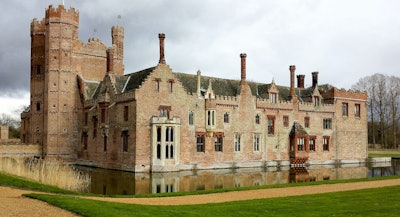
 Archaeologist Matt Champion looks beneath the floorboards in the attic of the manor. National Trust Photo
Archaeologist Matt Champion looks beneath the floorboards in the attic of the manor. National Trust Photo Fragments of a 15th-century illuminated manuscript discovered under floorboards. National Trust Photo
Fragments of a 15th-century illuminated manuscript discovered under floorboards. National Trust Photo
The attic floorboards of the moated Oxburgh Hall (circa 1482) were lifted to repair the floor joists, revealing thousands of artifacts preserved by a layer of lime plaster, according to the National Trust, a British heritage organization that cares for the historic property. One of the most remarkable finds in the rubble was a fragment of a 15th-century illuminated manuscript. The gold leaf and blue colors of the fragment were “still vibrant,” the National Trust stated.
Two long-abandoned rats’ nests also contained fragments of silk, velvet, satin, leather, wool and embroidered fabrics dating from between the second half of the 16th century and the 18th century. There were several scraps of handwritten music from the 16th century, as well as an empty WWII-era box of chocolates.
The haul is one of the largest “underfloor” archeological discoveries of its type in a National Trust house, the organization stated.




















